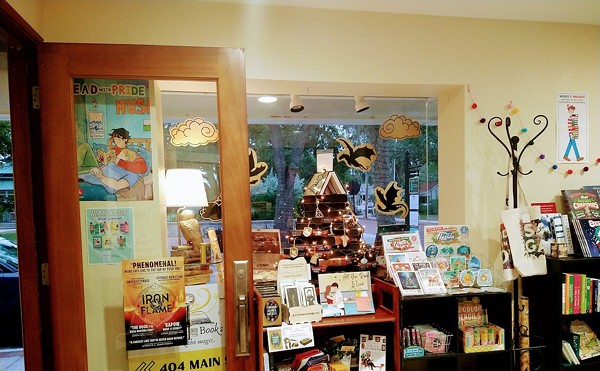The physical embodiment of emotion, dance combines the auditory and the visual with the purpose of communicating an idea – a feeling. It calls upon the imagination of the audience, almost more than any other art form, asking them to create a meaning out of movement.
Artists in the 21st century are experiencing a lack of support and funding. Challenging this difficult artist climate, Andee Scott, assistant professor of modern dance and choreography at the University of South Florida, created Sola. Consisting of six solo pieces choreographed and performed by seasoned female dance instructors from universities across the country, Sola debuted at USF on Aug. 29 and will tour through New York, Michigan, Texas and Vermont through the course of the next year.
The six solo pieces — although very separate in theme, aesthetic, purpose and execution — all challenged the audience of the very intimate Theatre 2 to dig deep into their emotional and intellectual catalog. Pure proximity allowed us to hear every breath and footstep on the wooden stage.
The show opened with “the edge of memory,” performed and choreographed by USF’s Andee Scott. Adorned in white from head to toe, Scott incorporated her common use of projections by using a video of ocean waves on a very tiny screen in front of the stage. Scott’s fluid and graceful movement, accompanied by Gracieli Scremin’s “As Dancas Noturnas,” mirrored the somber, gray image of the crashing waves on screen. Short and serene, the piece illuminated the simple beauty of the human body in motion.
The most polarizing of the six pieces, Amy Chavasse’s (University of Michigan) “Conspiracy Going,” seemed to be a rejection of the easy, digestible portrayal of contemporary dance on television. A mix of spoken word and dance, the piece was inspired by an anonymously authored text about solo performance (Fear as a Blunt Tool of Manipulation) found on the internet. Chavasse, with no musical accompaniment, performed the intensely personal piece with incredible athleticism and passion. Her verbal commentary on sadism and authority, matched by her powerful and aggressive physicality, was the most provocative piece of art I have seen in the past year.
Tzveta Kassabova of Middlebury College in Vermont made her entrance by walking hauntingly through the audience down the aisle stairs, with arms glued to her sides. Kassabova’s “Letter (to Ed)” perfectly showcased her unique style – a beautiful, chaotic combination of manic movement and exceptionally long, slender limbs. Including a few perfectly executed falls, the piece proved that seamless technique can exist without being fluid or graceful.
“You are That,” performed and choreographed by Pamela Pietro of New York University Tisch School of the Arts, was a celebration of the power of the female body. Pietro’s athleticism was the star of the performance. Her muscular strength rivaled that of her stage presence, as her intense eye contact with the audience, stage stomping and rhythmic clapping left us with no question that Pietro is a force to be reckon with (she also stayed en pointe for longer than I thought was humanly possible). Her physical power, along with ethereal lighting and foreign score, made the piece feel spiritual.
USF’s own Bliss Kohlmyer’s “Yours or Mine” was an unintentional combination of all the styles and strengths of the Sola women’s works. She incorporated spoken word, intense athleticism, and deep emotional meaning into the piece. The verbal portion of the piece was an examination of the meaning “truth.” Visually, Kohlmyer’s technique was hypnotizing and nearly flawless – it felt like a privilege to watch her dance. In what was my favorite moment of the evening, Kohlmyer blew a ferocious kiss to the audience at the end of the piece, simultaneously extinguishing all light in the theater. Gasps ensued.
A definite crowd favorite, “Lest We Forget” was an ideal finale for Sola. Choreographed by Ursula Payne and performed by the critically lauded Mary Williford-Shade (Texas Woman’s University), the piece featured Williford-Shade in a long red dress and a rocking chair placed center stage. Incredibly enough, she made the rocking chair her dance partner in the piece. With the slightest touch, the chair would move with her. Williford-Shade’s ability to control this prop and move so gracefully around it seemed symbolic of the power women have in this field.
Sola pushed us to the furthest point of our imaginations and intellect. It is a perfect display of every physical, stylistic and emotional female presence in dance in the 21st century.
As I was walking down the steps of the theatre at the end of the performance, a woman in front of me said with the utmost sincerity, “Everyone needs to see this.” I cannot help but agree.
















